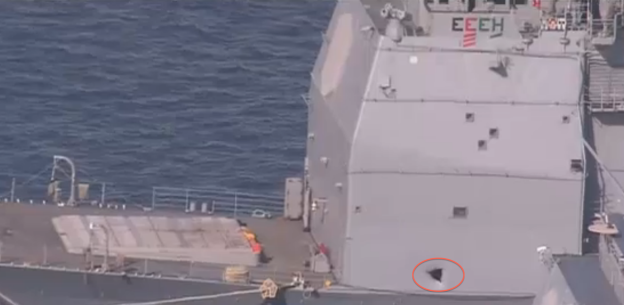
Engineers with U.S. Navy are still tallying the damage caused when a 13-foot target drone punched a three to four foot hole in the side of guided missile cruiser USS Chancellorsville (CG-62) on Saturday, Navy officials told USNI News on Tuesday.
Footage from NBC 7 San Diego showed a ragged hole in the ship just aft of the forecastle in the port side of Chancellorsville’s superstructure while the ship was in port at Naval Station San Diego, Calif on Monday.
The collision affected “some internal spaces,” of Chancellorsville, though officials would not specify which spaces were damaged. The point of impact is near the ship’s Command Information Center (CIC), one of the best-armored and most sensitive areas of the ship, as well as the control room for the Aegis radar system.
The Northrop Grumman BQM-74 target drone hit the ship about 1:25 PST on Saturday during a, “tracking exercise during an air tracking event,” resulting in “minor injuries to two sailors,” according to Navy officials.
The crew of the Chancellorsville — armed with the Navy’s most advanced Aegis weapon systems — was performing a Combat System Ship Qualification Trials (CSSQT) to asses the installation of the ship’s Baseline 9 Aegis combat system.
The Navy conducts CSSQT (colloquially called C-Squat) for new ships or ships that have undergone a complex weapon systems refit.
During the test, according to the Navy, the operator of the BQM-74 — used to simulate missiles or aircraft — lost control of the drone before it punctured the ship.
The Navy did not confirm if the ship’s crew attempted to employ the ship’s self-defense systems to protect the ship from the errant drone.
Chancellorsville fields two Phalanx Close-in Weapon Systems (CIWS) designed to intercept and destroy threats close to the ship. The two 20mm Gatling guns paired with radar detect and track low flying targets heading toward the ship.
Depending on the type of training, the crew may not have been required to arm the CIWS defenses.
The flight plans of BQM-74s are typically built with a so-called offset that in the event of the loss of control of the target, the drone would not pass close enough to endanger the ship.
BQM-74s have long been in the Navy inventory and serve as targets for the Standard Missiles as part of the Aegis systems. The target drones are not autonomous and are controlled and tracked by personnel at ground stations. BQM-74s would not typically used as targets for the CIWS defenses as the risk of striking the ship would be too high.
The target crash into Chancellorsville is not the first time a safety offset of a BQM-74 target has failed.
During a CSSQT for guided missile destroyer USS Russell (DDG-59) in 1995, an errant BQM-74 was destroyed by the ship’s CIWS during a live-fire missile shoot that was intended to test the ship’s surface-to-air Standard Missile and Aegis combat system.





